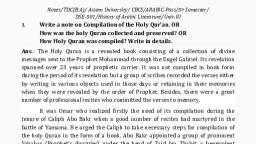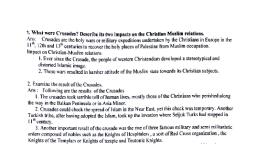Page 1 : Notes/TDC(B.A)/ Assam University/ CBCS/ARABIC-Pass/5th Semester/, DSE-501/History of Arabic Literature/Unit-I, 1., , (A) Define/ What is/ What do you understand/mean by Pre-Islamic poetry?, , Ans:- Pre-Islamic Poetry means the poems which have been contributed in poetic forms by poets in, the centuries preceding Islam. It constitutes a major source for classical Arabic language both in, grammar and vocabulary, and as a reliable historical record of the political and cultural life of the, Arabs of that time., (B) Define/ What is/ What do you understand/mean by Qasida., Ans.: The long Arabic poem consisting of two hemistiches and mono-rhymed in structure,, imaginative and lyric in form and realistic in manner is called Qasida., (C) Write about Origin and Development of the Pre-Islamic poetry., OR, Write Growth and Development of the Qasida., Ans:- Many historians opine that Arabic poetry originally developed through Kalam Mursal, (rhymed prose). However, the oldest form of Arabic poetry was ‘Saj’ (pigeon's coo), which means, rhyme without meter and it is originated for singing. It was very simple and suitable for use and, confined in invocations, divinations and forecasts of seers and priests. From ‘Saj’ it is gradually, developed to ‘Razaj', which means a short iambic of verse that always ending with the same rhyme., Razaj was also very simple and suitable and poetic form that was composed in more disciplined and, systematic way. The scheme (meter) of Razaj poetry is Mustaf’ilun Mustaf’ilun (twice). Mudhar bin, Nizar is called the first composer of Razaj. In beginning, it consisted of two or three verses., Then the next other form ‘Qasidah’ developed progressively. It was composed in verses, (Bayts) of double the length of ‘Razaj’. Qasida was long poem over 25 lines consisting of two, hemistiches and mono-rhymed in structure. It was imaginative, lyric in form and realistic in, manner with obscure words, musical effect that gives true picture of then Arab life. The most, ancient kinds of Arabic poetry are the dirge (Ritha) and the vilifying verse (Hija)., In the 6th century A.D. Qasida got full perfection in both form and contents by started using, as self-glorification, praising of chieftain, description of heroic deeds, making love and apology in, addition to maxims, satires of enemies and elegies of deceased. It has to begin with an amatory, prelude than to the main theme., Finally, there are, 16 different measures were adopted for composing a Qasida and these, measures are called prosody. The famous Mua'llaqat poems are composed in four of these, measures., It may be noted here that many orientalists rejected the existence of the Pre-Islamic poetry, but most of historian believe that Pre-Islamic Arabic Poems were preserved orally from generation, to generation for hundreds of years and were finally reduced to writing in between 750-900 A.D., The credit goes to Abu Tammam, who compiled a lot of poems in his anthology “Hamasa”, and, Mufaddal Dabbi, who compiled “Mufaddaliat” for stocking these poems in the forms of writing., Another prominent stock is Kitab al-Aghani by Abul Farz Ispahani. Sab'ul Mua'llaqat is the very best, of these early poems that were collected in the 8th century., , By- Dr. Abu Nazat Sayful Haque, (M.M., M.A., Ph.D., NET,), Asst. Prof, Dept. of Arabic, S.R. College, Kalain, Cachar. 788815, Email:
[email protected]. M-9954863722 pg. 1
Page 2 : Notes/TDC(B.A)/ Assam University/ CBCS/ARABIC-Pass/5th Semester/, DSE-501/History of Arabic Literature/Unit-I, , 2., , Discuss about the characteristics and themes of the Pre-Islamic Poetry. OR, Discuss about the main features of the Pre-Islamic Poetry., OR, ( الشعر ديوان العربAs-shiru dewanul Arab) discuss/Elucidate the statement., , Ans.: Pre-Islamic poetry is the mirror of the intellectual and social condition of the Arabs. It, preserved their traditions, passions, ideology, battles, morals, even geography and fauna. Through, poetry they used to express their sentiments and opinions in time of danger and crisis of their, tribes. Henceforth, it is called the historical record or register of the Arab., Its themes include their petty inter-tribal bonds, the destructive guerilla warfare and, vendetta, the adventures, both heroic and comic of the wandering poets, the vilipending of misers, and cowards and praising of the tribe and its leaders and heroes., The most striking feature of pre-Islamic poetry is the uniformity and refinement of its, language. Arabic was even then a virile and expressive language, with dozens of synonyms and it, possessed a rich stock of descriptive adjectives. The strikingly rich vocabulary of classical Arabic, as, well as its sophisticated structure, is matched by highly elaborate metrical schemes, based on, quantity. One and the same rhyme letter had to be maintained throughout the poem., Pre-Islamic poems would often start with romantic or nostalgic prelude, in which a thematic, unit called "nasib", means that the poet would remember his beloved and her deserted home and its, ruins. This concept in Arabic poetry is referred to as "al-waquf `ala al-atlal" (standing by the ruins), because the poet would often start his poem by saying that he stood at the ruins of his beloved. In, pre-Islamic poetry more attention was given to the eloquence and the wording of the verse than to, the poem as whole. This resulted in poems characterized by strong vocabulary and short ideas but, with loosely connected verses., However, the main themes by which Pre-Islamic Arabic poetry is characterized are:, Al-Nasib: The erotic prelude to a poem., Al-Fakhr/Al-Hamasa: Self-glorification., Al-Hajw: Defamation of enemies,, Al-Ritha: Lamentation for a deceased,, Al-Madh: Praising of tribes, leaders and heroes., Al-Wasf: Description of a quality,, Al-Hikam: Morals and maxims., , By- Dr. Abu Nazat Sayful Haque, (M.M., M.A., Ph.D., NET,), Asst. Prof, Dept. of Arabic, S.R. College, Kalain, Cachar. 788815, Email:
[email protected]. M-9954863722 pg. 2
































































